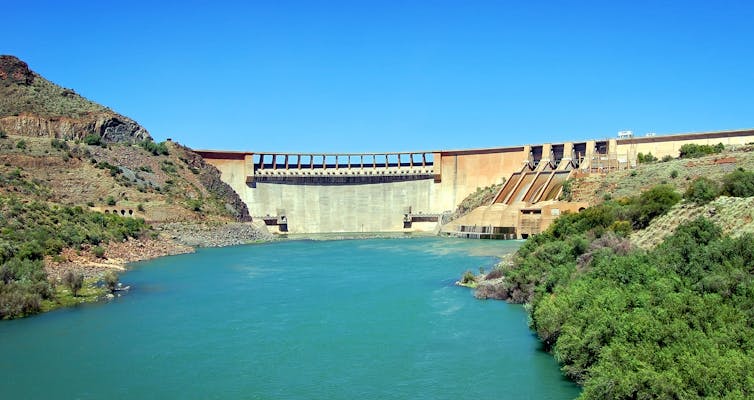
Solomon Kibret, University of California, Irvine
Many people in Africa are food insecure, vulnerable to shifts in climate and do not have access to electricity. There’s also a problem with accessing reliable, clean water, particularly in places with irregular rains.
Building dams is one way that African countries are trying to address these myriad issues. A number of large and small dams are currently under construction, particularly in sub-Saharan Africa.
But while dams could solve some problems, it may also bring new ones – like malaria. Water is crucial to the spread of this mosquito-borne disease. That’s because mosquitoes breed and lay their eggs in or near bodies of water. The insects prefer shallow pools for these purposes, and dams provide shorelines that offer just this: many shallow pools.
The number of people living close to (less than 5 km away) large dam reservoirs in sub-Saharan Africa increased from around 14 million to about 19 million between 2000 and 2015, according to our study. Nearly 75% of the population stays in areas where there is malaria. During the same 15 year period, the number of large dams increased from 884 to 919 in Africa. These figures are conservative, since only two-third of African dams are registered in the World Register of Dams database.
At least one million malaria cases can be attributed to large dams in Africa each year. But the relationship between dams and malaria is not entirely straightforward. Dams don’t always increase malaria cases. When they do, the degree of increase is not uniform. So it’s important to explore the factors that determine malaria risk around Africa’s large dams.
That’s what our study set out to do. Using topographic data, we unpacked the relationship between large dams and their characteristics, like altitude and rainfall, linked to malaria in sub-Saharan Africa. The study used satellite data to accurately measure elevation, slope and surface areas of African reservoirs in four time periods – 2000, 2005, 2010 and 2015.
We found that there were a number of factors that increases the risk of malaria in areas close to larger dams. The slope of the dams shoreline was the most important risk factor.
Key findings
We looked at a number of environmental variables such as altitude, rainfall, temperature and the slope of the reservoir shoreline to identify factors that contribute to malaria transmission in a given region. Here’s why we chose those four factors.
Altitude: Malaria used to be a lowland disease. But evidence shows that climate change is helping malaria encroach to highlands where the disease was uncommon.
Rainfall: This governs the occurrence of rain pools and puddles which are favourable habitats for mosquito breeding. Rain affects the nature of the shoreline of dams by creating puddles around the reservoir shoreline.
Temperature: This determines the rate of a mosquito’s growth in the water and the development of the malaria parasite inside adult mosquitoes. Similarly, biophysical factors such as geography and land use can influence the suitability of habitats for mosquito development.
Slope: This is the most important predictor of the level of malaria around dam. Our analysis showed that in regions which are otherwise suitable for mosquito breeding, the slope of the reservoir shore plays the largest critical role in determining the occurrence of malaria in the vicinity of dams. Reservoirs with higher slope at shoreline have lower malaria impacts. Conversely, reservoirs with lower slope at shoreline have higher malaria impacts.
Mosquitoes prefer to breed in shallow puddles created around shorelines which are often free of predators such as fish and tadpoles. Hydrologically, slope determines how likely an area is to retain surface water. Gentle slope generally corresponds to poor drainage, promoting the persistence of surface water bodies and the formation of stable pools that are good habitats for mosquito breeding.
In contrast, a steeper slope facilitates drainage. It reduces the likelihood that pools will form for periods long enough for mosquitoes to complete their aquatic development.
The problem is that in many African countries, agricultural practices are more common on gently sloping shorelines. This means there’s more space available for malaria mosquitoes to breed.
So what can be done?
The world is striving to eliminate malaria. The World Health Organisation has set a target of reducing global malaria cases and mortality rates by at least 90% by 2030. But dam reservoirs will continue to be focal points for malaria transmission in sub-Saharan Africa – a region where 90% of the global malaria burden exists.
More rigorous impact prediction assessments must be done at the planning stages to determine the likely malaria impacts when considering new dams. Greater consideration must be given to the slopes of reservoir shores and the implications for malaria.
In short, the slope of reservoir shores should be considered when siting a new dam. Water managers and health managers need to collaborate much more closely to alleviate malaria risks.
Solomon Kibret, Researcher, University of California, Irvine
This article is republished from The Conversation under a Creative Commons license. Read the original article.
